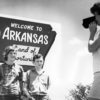calsfoundation@cals.org
Gangster Museum of America
The history of Hot Springs (Garland County) and its role in Arkansas and American history has, since 2008, been brought to life in the award-winning Gangster Museum of America, located at 510 Central Avenue in downtown Hot Springs. The museum was founded by Robert Raines, under the umbrella of Historical Attractions, Inc. (a for-profit corporation), and was the recipient of the 2009 Tourism of the Year Award in Garland County. It was also a 2011 Henry Award finalist in the Arkansas Heritage category.
Although there are many artifacts and hundreds of photo exhibits, the museum experience is driven by a tour guide who navigates a series of eyewitness accounts on high-definition video presentations of those who lived through the “glory days” of Hot Springs. Former agents of the Federal Bureau for Investigation (FBI), U.S. marshals, Arkansas State Police directors, lawyers, and a brothel madam who worked inside the largest illegal gambling operation in the United States give candid testimony, as do local historians.
The tour begins in the Power Brokers Gallery with the chronicles of Leo Patrick McLaughlin. McLaughlin and Judge Verne Ledgerwood ruled over the city from 1927 to 1947, during which time they had wide-open gambling policies, before being ousted by Sid McMath and Q. Byrum Hurst Sr. during the GI Revolt of 1946. The GIs were aided by the knowledge and experience of former New York gangster Owen Vincent Madden. The Madden Gallery explores how Madden became the architect of the way Hot Springs would function in a state that forbade illegal gambling. This would involve the tolerance—and even support—of Arkansas governors such as Junius Futrell, Ben Laney, Francis Cherry, and Orval Faubus.
One of Hot Springs’ most famous visitors and frequent guests of the Arlington Hotel is featured in the Al Capone Gallery. A first-hand account of Capone’s love for the area is presented in a video interview with Deirdre Marie Capone, the granddaughter of Capone’s brother, Ralph Capone. The gallery is augmented by Prohibition-era artifacts, purchased by the museum from collectors around the country.
The Prohibition era not only brought infamy to Madden and Capone but also spawned a period of lawlessness that is represented in the Outlaw Gallery. Bank robbers such as Alvin Karpis, Frank “Jelly” Nash, and Karpis’s common-law wife, madam Grace Goldstein, share wall space with other notorious visitors to the area, such as Bonnie and Clyde, John Dillinger, and Charles Arthur “Pretty Boy” Floyd. The city gained national attention when higher-caliber criminals—such as Meyer Lansky, Frank Costello, and Charles “Lucky” Luciano—began enjoying the amenities of Hot Springs while visiting Madden. Their story is on display in the New York Connection Gallery.
The penultimate stop on the tour takes visitors to the Casino Gallery, where antique casino equipment is exhibited, along with a video presentation that includes madam Maxine Temple Jones, Colonel Lynn Davis (the state police director in charge of closing the Hot Springs casinos), and Governor Winthrop Rockefeller. To complete the experience, visitors can take a video trip under the city, exploring the tunnel below Central Avenue.
For additional information:
Gangster Museum of America. http://www.tgmoa.com (accessed October 14, 2021).
Nown,Graham. Arkansas Godfather: The Story of Owney Madden and How He Hijacked Middle America. Little Rock: Butler Center Books, 2013.
Raines, Robert K. Hot Springs: From Capone to Costello. Charleston SC: Arcadia Publishers, 2013.
Schuman, Kate. “Mobsters, Molls, Moonshine.” Arkansas Democrat-Gazette, August 14, 2008, pp. 1E, 6E.
Robert K. Raines
Historical Attractions, Inc.
 Historic Preservation
Historic Preservation Law
Law Tourism
Tourism




Comments
No comments on this entry yet.